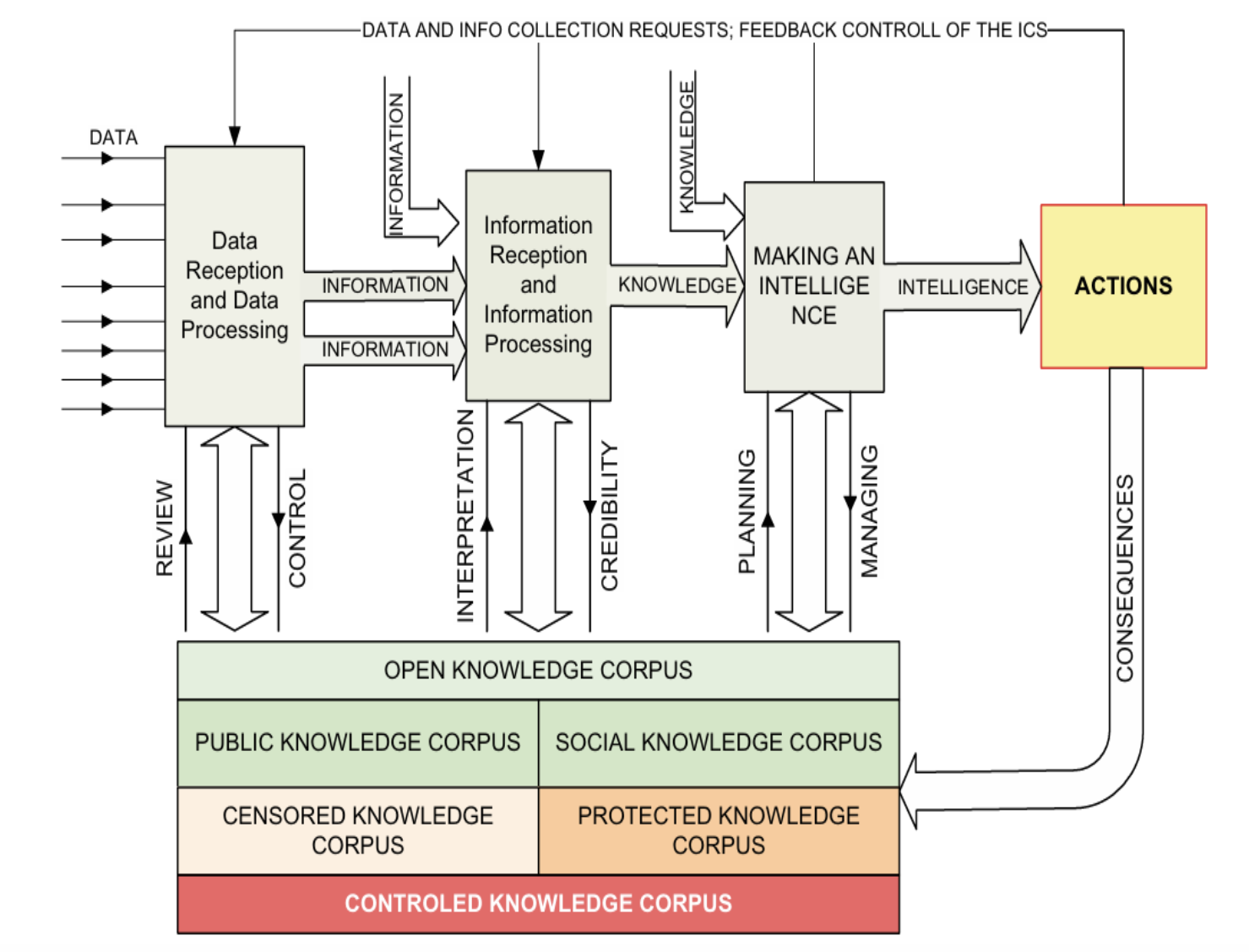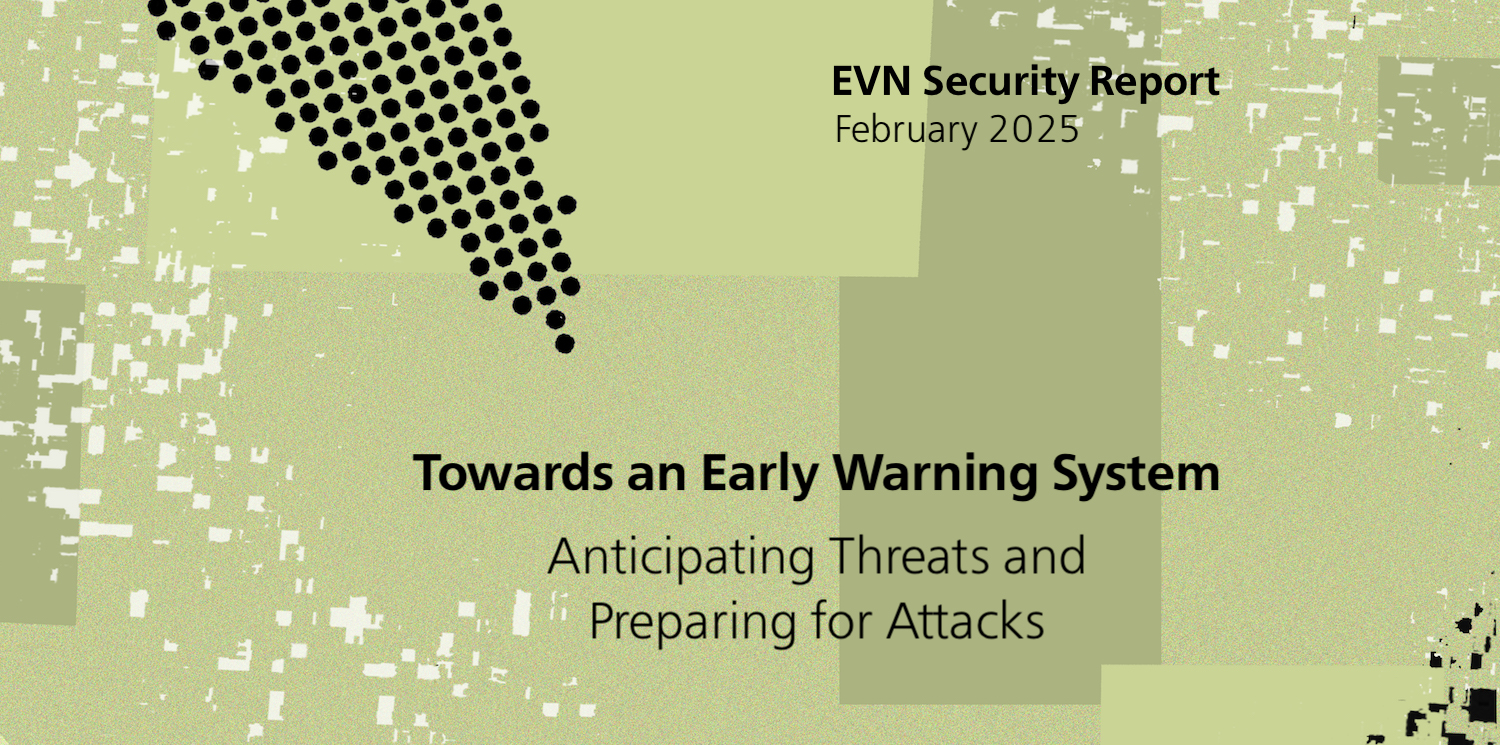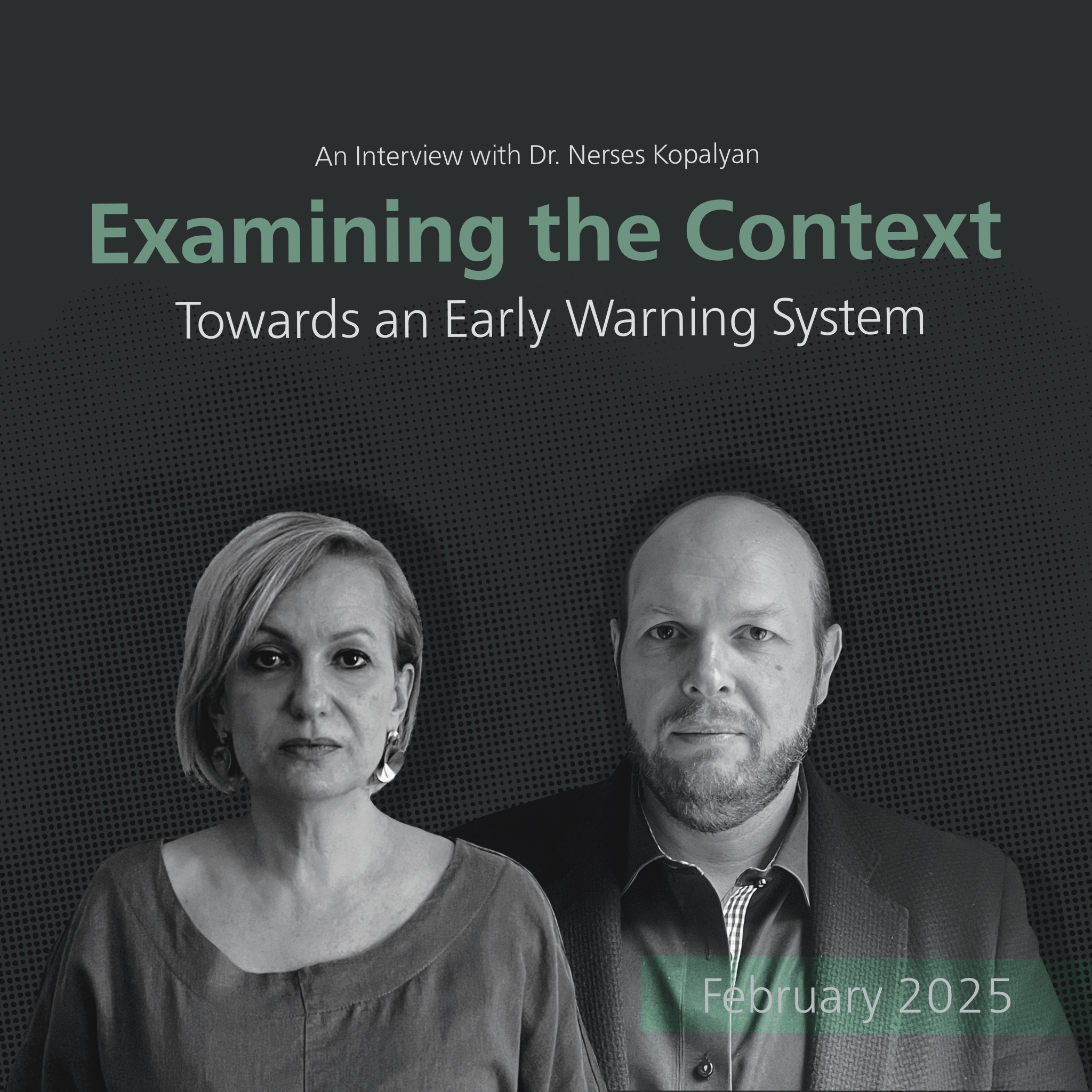Listen to the EVN Security Report.
At the structural level, Armenia’s security environment is confronted with a four-front battle that is defined by direct physical security threats, long-term neo-imperial threats, hybrid warfare attacks, and disinformation campaigns within the Armenian domain.
The first and immediate sphere of threat is the physical security danger posed by Azerbaijan, which requires the expansive utilization, if not the entirety, of the Armenian state’s resources in mitigating and combating this threat. The second level of threat, which is qualified within the domain of long-term strategic considerations, is the neo-imperial threat posed by Russia (and in certain instances Turkey), specifically within a 5 to 10 year trajectory and Moscow’s ambitions of reasserting its regional sphere of influence. The third level of threat, within the domain of continuity, is the amplified hybrid warfare tactics of Azerbaijan and the intermittent hybrid attacks by Russia designed to disrupt and weaken Armenia’s resilience and rebuilding capabilities. The fourth level of security threat, while being relatively the most minimal, is within the disinformation campaigns unleashed against Armenia’s burgeoning democratic culture, with the intent of instituting continuous domestic political instability, an endeavor primarily initiated by illiberal forces within Armenia and the Diaspora.
The scope and range in which these threats intertwine, such as Russia working with Azerbaijan to enhance threat severity within the first sphere, or Armenia’s pro-Russia opposition, supported by ARF-affiliated organizations in the Diaspora, proliferating disinformation to reinforce polarization or initiate domestic instability, thus enhancing the threat severity within the third and fourth spheres, demonstrate the multifaceted nature of the threat matrix. In this context, the Armenian state and its nascent democratic system is subjected to direct, long-term and indirect hostilities, along with an informal, yet well-coordinated information warfare campaign.
Armenia’s approach to addressing these threats has relied on a two-tiered mitigation model: 1) in the face of direct and long-term threats, Armenia has relied on the diplomatization of its security followed by increased spending on enhancing its deterrence capabilities; and 2) in the face of indirect threats and disinformation campaigns, Armenia has initiated de-hybridization and resiliency modeling. Considering the multi-tiered and multifaceted nature of the threats facing Armenia, the country’s limited capabilities have always forced it to address threats reactively. With new and limited instances of proactive modeling being applied to the first sphere of direct threats posed by Azerbaijan, much of Armenia’s tactical and strategic capabilities remain reactive. This approach is about to change, as Armenia’s developing National Security Strategy, and its adaptation of a small-state comprehensive security doctrine, will lay the foundations for developing early warning capabilities. This security report offers a window of what this early warning system will structurally look like.
Armenia’s mitigation model for the first sphere of threats posed by Azerbaijan has relied on sets of ongoing proactive measures, most important of which have been the European Union’s Observation Mission, deepening of institutional relations with Europe, enhancement and strengthening Armenia’s presence in Washington DC, and reifying relations with pertinent Diasporan interests. These endeavors have been supplemented by establishing healthy communication with regional stakeholders along with a wide range of strategic partners. While these proactive measures are designed to offer Armenia layers of soft deterrence, at the systemic level, especially when confronted with the remaining three levels of threats, Armenia’s proactive capabilities remain inherently underdeveloped.
Risk-mitigation, Data and Intelligence Processing
Lack of early warning capabilities, and a general reliance on a reactive strategic approach, not only limits the depth and scope of options available for Armenia in confronting its matrix of threats, but more so, decision-making becomes handicapped due to the logic of “catching up” and incomplete or incorrect information. The literature in Intelligence Studies (IS) provides six general sets of errors and shortcomings that are inherent to erroneous or incomplete decision-making within the domain of risk calculation:[1]
- Lack of sufficient data and relevant information on which decisions can be based.
- Incapacity or a general inability to process and recognize the interconnectedness and systemic relationship between existing and collected data/information.
- Inability to distinguish between operationalizable data/information and marginally irrelevant information.
- Bureaucratization, institutional negligence, and organizational defects of the system responsible for processing the collected data and information, and an inability to accurately develop analytical output for end users.
- Distrust of decision-makers in the quality and capabilities of institutions responsible for the collection, processing, and operationalization of the data and information ascertained.
- Making decisions on limited, incorrect, misinterpreted, or flawed data stemming from bad sources or flawed processes that produce or give way to detrimental decisions and results.
Because early warning systems are fundamentally reliant on data and information, the ability of such systems to work and allow for proactive decision-making requires a well-established process by which the data is processed, information integrated, intelligence produced and actionable decisions made. The systemic and methodological factors informing the process remain crucial, for the most effective early warning systems are those that most correctly and accurately produce outputs based on the data and information collected. One of the most effective processes is the one used by the Ukrainians, and developed with the assistance and expertise of Western partners, known as the Data-Information-Knowledge-Intelligence Conversion (DIKIC) process (figure below). While noting Russia’s immense superiority in all the domains of the threat matrix that Ukraine faced, Ukraine was still able to anticipate, predict and preempt a great deal of the operational and tactical objectives of the Russians, regardless of the asymmetrical disparity.

Armenia has the distinct ability not only to develop a system similar to the model above, but also to utilize artificial intelligence and machine learning, areas where the country is making important advances. This provides an acute advantage in developing the foundation for an advanced early warning system. The technical nuances of this approach, for obvious and security reasons, cannot be discussed here, but the factor to consider is the importance of an information processing model that produces actionable intelligence that can be fed into the early warning system.
The Structure of an Armenian Early Warning System
Two postulates are fundamental in developing an early warning system for Armenia: 1) Armenia must always treat the conflict with Azerbaijan as a given regardless of any possible resolutions or peace in the near or distant future; and 2) Armenia must operate off of the principle that risk propensity will continuously be high in the region and it needs to always be ready for worst-case scenarios. The first postulate pertains to the first (Azerbaijan) and third (hybrid warfare) levels of threats, while the second postulate is specific to the second (Russia’s and potentially Turkey’s neo-imperial ambitions) and fourth (disinformation campaigns of the illiberal forces domestically and in Diaspora). Early warning is designed to respond to the constant threat of war, and to a set of circumstances where enemies demonstrate intentions of destroying Armenia’s sovereignty. The latter is applicable not only to Azerbaijan’s intentions, but also the aligned intentions of Russia, Armenia’s pro-Russia opposition, and the ARF-linked groups in Diaspora, all of whom qualify Armenia being a vassal of Moscow or an absorbed part of a Union State (similar to Belarus) as preferable outcomes.
While the Intelligence Community (IC) is responsible for providing early warning, Armenia’s IC has traditionally relied on the National Security Service (NSS), whose tools, resources, and capabilities were limited and Russia-reliant, an intrinsic contradiction in terms. Military intelligence, part of all ICs, remains underdeveloped in Armenia, making up only a small department within the General Staff of the Armed Forces. The potential game-changer within this domain is the recent establishment of the Foreign Intelligence Service (FIS), adding a layer of structural coherence to Armenia’s otherwise inchoate IC system. In the operationalization of early warning systems, FIS remains the primary institution that will lead the task of accruing, processing, analyzing, and offering operationalizable output for decision-makers. A large body of research offers empirical support to the efficacy of early warning systems if they are based on rigorous methods and tested models.
Early warning systems are broken down into three types: strategic warning, operational warning and tactical warning. For Armenia, strategic early warning will be the domain of the FIS, operational early warning will entail the collaboration of the FIS and the NSS, while tactical early warning will fall within the responsibility of the NSS and operationalized through the military. To provide more clarity, let us consider what each of these warning domains mean for Armenia’s early warning system.
Strategic early warning primarily entails a comprehensive understanding of the threat posed by an opponent(s), the strategic state of affairs defining the circumstance, and is processed based on information specific to threats, challenges, shifts, behavioral patterns, and fluctuations in the risk-propensity of enemy activities. Strategic early warning connects the tangible and conceptual dimensions of developments or pending developments (based on predictive modeling), demonstrating changes in strategic conditions and resultant shifts or disruptions in patterns. Strategic early warnings are designed to indicate to decision-makers any need or growing necessity to redesign existing strategic approaches or policies, including redefining the logic, objectives, intentions and risks that are in a state of continuous development.
Similar to the US Defense Advanced Research Projects Agency’s Integrated Crisis Early Warning System, though on a much smaller scale, the strategic early warning models used by the FIS will rely on forecasting techniques to buttress the DIKIC process. As outlined in Armenia’s threat matrix, first, second and fourth-level threats will primarily fall within the domain of strategic early warning. In this context, intelligence outputs will be generated for decision-makers on key threats to Armenia, including Azerbaijan’s physical threat, Russia and Turkey’s long-term threats, and the coordinated disinformation campaigns across the Armenian nation by illiberal forces. Collectively, strategic early warning will primarily be led by the FIS, with output transferred to the National Security Council (NSC), after which it will be shared with the Office of the Prime Minister. Upon collective consideration, the information will be proliferated to other pertinent ministries.
Operational early warning is designed to allow for operational art and operational planning, that is, the implementation and operationalization of the pertinent early warning intelligence. As with early strategic warning, operational early warning seeks to link the tangible and the conceptual dimensions of information, but within the domain of early operations planning. The output from the FIS will be utilized by the NSS to develop operational plans and mechanisms of implementation, offering proactive and preemptive capabilities to mitigating imminent or escalatory risks. Within the domain of risk levels, operational early warning will primarily deal with level one and level three, as direct physical threats by Azerbaijan and the broader hybrid warfare initiated by Azerbaijan and Russia will remain the operational responsibility of the NSS.
Tactical early warning refers to an environment in which the concerns are physical and tangible, and as such, the concentration is on time and place. It involves concrete actions to address an imminent threat, and by extension, the deployment of force. Strategic and operational early warnings inform tactical early warning, as the former processes the information pertinent to its threat level, while the latter draws up proactive operational plans. Tactical early warning entails the concrete use of force, or based on the circumstance, action to preemptively mitigate the threat. Within the domain of domestic security, such as terrorist threats against the state, tactical early warning remains the responsibility of the NSS. For external threats, or anticipated incursion into border areas, tactical early warning remains the responsibility of the military.
Conclusion
As Armenia adapts its comprehensive security strategy, its whole-of-society and whole-of-government approach will rely heavily on anticipating and mitigating shocks to the system to enhance its resiliency. Early warning systems will be crucial to this endeavor, for resilience requires proactive policies and agile decision-making, and this, itself, requires the processes and mechanisms inherent to early warning systems. Whether we are addressing Armenia’s capacity for de-hybridization, combating kinetic diplomacy, neutralizing misinformation campaigns, or developing long-term deterrence capabilities, Armenia’s core strengths will rely on being ahead of the game. In no uncertain terms, as Armenia turns into the region’s porcupine, its strategic, operational, and tactical early warnings will determine its success in the asymmetrical domain, and provide a vital tool that Armenian society has lacked for decades: confronting uncertainty.
Footnotes:
[1] Milan N. Vego. 2007. Joint Operational Warfare Theory and Practice. Newport, RI: Naval War College Press
EVN Security Report
Why Aliyev Thinks He Has to Attack Armenia Soon
Ilham Aliyev considers the new regional balance of power his greatest geopolitical success and the preservation of this power disparity with Armenia his highest priority. As Armenia rearms and seeks to develop deterrence capacity, Aliyev deems this a threat to his grand strategy, thus heightening the probability of strategic strikes against Armenia.
Read moreEVN Security Report: November 2024
Looking at the emerging contours of the Trump Doctrine and its implications for the South Caucasus, Nerses Kopalyan examines competing policy orientations within Trump's incoming administration and how these will shape U.S. engagement with Armenia amid broader global and geopolitical priorities.
Read moreEVN Security Report: October 2024
Tracing decades of overreliance on Russia, systemic neglect of military modernization, and policy failures by successive Armenian administrations, Nerses Kopalyan presents a critical analysis of how Armenia’s security apparatus stood by as Azerbaijan became a regional military power.
Read moreEVN Security Report: September 2024
Armenia faces distinct security threats from Azerbaijan, Turkey, and Russia, with Russia posing the most complex and severe challenge through cyber operations. This month's security briefing explores the concept of subversion as a tenable risk-mitigation strategy against these threats.
Read more












Thank you for a very interesting and informative podcast. Regarding Armenia-Russia relations my fear is that Trump will give carte blanche to Putin to basically do whatever he wants in the ex-USSR territory after ceasefire with Ukraine – maybe not in Baltic states. IN other wards this is yours and this is mine and we don’t bother each other and just think of profits. … This may be very detrimental to Armenia . DO you anticipate something like this? Also very interesting is Turkey’s participation with Europeans in talks about Ukraine. I feel there will be a shift in the balance of powers but I don’t have any knowledge to analyze all this. Maybe this is topic for another podcast ))